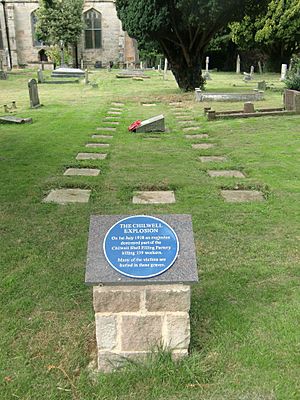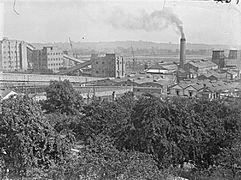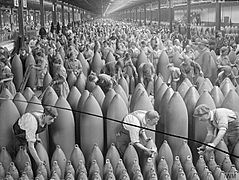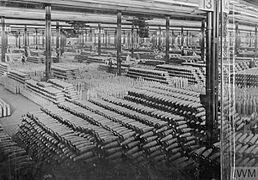Chilwell Filling Factory Memorial facts for kids
The Chilwell Munitions Workers Memorial is a special monument. It stands in Chetwynd Barracks in Chilwell, near Nottingham. This memorial remembers the brave workers who died. They worked at the National Shell Filling Factory, Chilwell during World War I. Many died in accidents, especially in a huge explosion on July 1, 1918. The monument is shaped like a pyramid. It was first shown in 1919. Today, it is a protected building, known as a Grade II listed building.
Contents
What Happened During the War
When World War I started in 1914, Britain needed many more weapons. But they couldn't make enough shells fast enough. This problem was called the "Shell Scandal" in 1915. So, the government decided to build new factories. These were called National Factories.
The Chilwell Factory
One of these was National Filling Factory No. 6. It was built in Chilwell, Nottinghamshire. This factory's job was to fill empty shells with explosives. It opened in February 1916. Workers filled large shells with a powerful explosive called amatol. This was often made right there, by mixing TNT with ammonium nitrate.
A man named Godfrey Chetwynd, 8th Viscount Chetwynd was in charge. He made the factory very efficient and safe. By 1916, they were filling 130,000 shells every week. This used about 900 tons of amatol.
The Big Explosion
In its first two years, there were a few small blasts. These killed one or two people each time. But a massive explosion happened on July 1, 1918. About 8 tons of explosives blew up. It destroyed many buildings, including the Mixing House. The blast was so strong it shook buildings up to 3 miles (5 km) away.
This explosion killed 134 people. This was more than half of all deaths in National Filling Factories during the war. Among the dead were 25 women. All the workers in the Mixing House were lost. Only 32 bodies could be identified. Another 250 people were hurt. Firefighters quickly put out the fires. They stopped another 15 tons of TNT from exploding. Even with all the damage, the factory was fixed fast. It started filling shells again the very next day.

The people who died were buried in mass graves. This was at the church in Attenborough. Officials looked into what caused the explosion. They even checked for sabotage. But they never found a clear reason for the blast.
Some workers showed great bravery during the explosion. Twelve of them received the British Empire Medal. The factory manager, Arthur Hilary Bristowe, also got an Edward Medal. He bravely tipped burning TNT off conveyor belts.
Later, the factory site became an army depot. Today, it is still part of Chetwynd Barracks.
About the Memorial
The memorial stands on Chetwynd Road. It is near where the factory's Mixing House used to be. This is thought to be the spot of the big explosion. It honors everyone who died at the factory. This includes the 134 people killed in July 1918.
How it Looks
The factory's own workers built the memorial. Mr. S.A. Kay, the construction manager, oversaw the work. It is a large concrete pyramid shape. It stands on three steps. A short stone pillar is on top. Around the top step are shell casings. Chains connect them, and they are all painted white. There is an opening towards the road. A low wall and hedge surround it on three sides.
What it Says
Stone panels on the pyramid have messages carved into them. The front panel faces the road. It has Lord Chetwynd's special symbol. It also has the main message: "ERECTED / TO THE MEMORY OF THOSE / MEN AND WOMEN / WHO LOST THEIR LIVES BY EXPLOSIONS / AT THE NATIONAL SHELL FILLING FACTORY / CHILWELL / 1916 TO 1918"
Below this, it shares amazing facts about the factory's work: "PRINCIPAL HISTORICAL FACTS / OF THE FACTORY / FIRST SOD TURNED 13TH SEPTEMBER 1915 / FIRST SHELL FILLED 8TH JANUARY 1916 / NUMBER OF SHELLS FILLED / WITHIN ONE YEAR OF / CUTTING THE FIRST SOD / 1,200,000 / TOTAL SHELLS FILLED / 19,359,000 / REPRESENTING 50.8% OF THE TOTAL / OUTPUT OF HIGH EXPLOSIVE SHELL / BOTH LYDDITE AND AMATOL 60PD TO 15INCH / PRODUCED IN GREAT BRITAIN DURING THE WAR / TOTAL TONNAGE OF EXPLOSIVE USED / 121,360 TONS / TOTAL WEIGHT OF FILLED SHELL / 1,100,000 TONS"
Unveilings and Dedications
The memorial was first shown to the public on March 13, 1919. William Cavendish-Bentinck, 6th Duke of Portland did the unveiling.
After World War II, a new bronze plaque was added. It has a military badge. This plaque says: "TO THE GLORY OF GOD AND / IN MEMORY OF THOSE WHO GAVE / THEIR LIVES IN TWO WORLD WARS / AT THE GOING DOWN OF THE SUN / AND IN THE MORNING / WE WILL REMEMBER THEM / THEIR NAME LIVETH / FOR EVERMORE"
The memorial was honored again on June 30, 1968. This was 50 years after the big explosion. Another bronze plaque was added. It records that James Boyden MP, a government official, unveiled the restored monument. It also mentions the factory's nickname, "The V.C. Factory." This was to recognize the workers' "BRAVERY AND FORTITUDE."
In 1987, the Chilwell memorial became a Grade II listed building. This means it is an important historical site.




